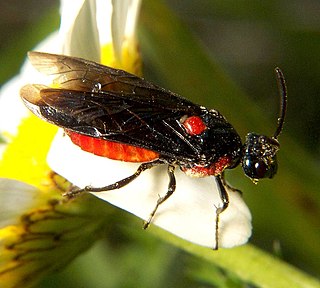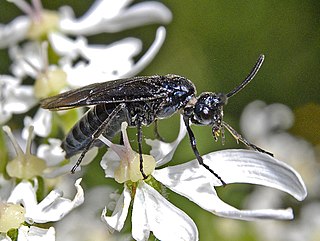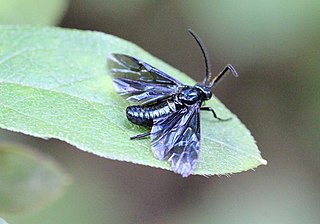
Sawflies are wasp-like insects that are in the suborder Symphyta within the order Hymenoptera, alongside ants, bees, and wasps. The common name comes from the saw-like appearance of the ovipositor, which the females use to cut into the plants where they lay their eggs. The name is associated especially with the Tenthredinoidea, by far the largest superfamily in the suborder, with about 7,000 known species; in the entire suborder, there are 8,000 described species in more than 800 genera. Symphyta is paraphyletic, consisting of several basal groups within the order Hymenoptera, each one rooted inside the previous group, ending with the Apocrita which are not sawflies.

The Tenthredinoidea are the dominant superfamily of sawflies within the Symphyta, containing some 8,400 species worldwide, primarily in the family Tenthredinidae. All known larvae are phytophagous, and a number are considered pests.

Argidae is a large family of sawflies, containing some 800 species worldwide, primarily in tropical regions. The larvae are phytophagous, and commonly can be found feeding in groups, though very few attain pest status.

The Blasticotomidae are a very small family of sawflies, containing only 13 species in 3 genera worldwide, restricted to temperate regions of Eurasia where the larvae are specialized stem borers of ferns.

The Pergidae are a moderate-sized family of sawflies occurring in the Western Hemisphere and the Australasian Region. The Pergidae are, with almost 450 described species, the third-largest family of Symphyta after the Tenthredinidae and the Argidae. Morphologically, most pergids are typically sawfly-like, but the form of the antennae varies considerably in number of segments and from simple to serrate and pectinate or even bipectinate. Sexual dimorphism is common and reflected in differences in type of antennae, colour, and size. Included are some of the few known apterous sawflies, those of the genus Cladomacra occurring in Papua New Guinea and Indonesia, and a species with brachypterous females, Clarissa tasbates, in Tasmania.

Arge scapularis or elm argid sawfly is a sawfly in the family Argidae. It is found across North America and commonly infests elm trees. The name "scapularis" refers to the insect's distinctive so-called "shoulder blades".
Zenargomyia is a genus of tachinid flies in the family Tachinidae from New South Wales. It is a parasite on the Cypress Pine Sawfly Zenarge turneri.

Arge berberidis, common name berberis sawfly, is a species of sawflies belonging to the family Argidae subfamily Arginae.

Arge pectoralis, the birch sawfly, is a species of argid sawfly in the family Argidae. This sawfly is present in North America.

Schizocerella pilicornis, commonly known as the purslane sawfly or portulaca sawfly, is a species of sawfly in the family Argidae. The larva is a leaf miner on Common Purslane.

Schizocerella is a genus of sawflies in the family Argidae. There are at least two described species in Schizocerella.

Sphacophilus cellularis is a species of sawfly in the family Argidae.
Aprosthema is a genus of insects belonging to the family Argidae.

Arge similis, common name azalea argid sawfly, is an insect species from the family Argidae. The species was originally described by Samuel Constantinus Snellen van Vollenhoven.
Zenarge turneri, also known as the cypress pine sawfly or callitris sawfly, is the only recognized species in its family Zenargidae and the genus Zenarge. It is found in Australia and is known as a pest in New South Wales due to its predation of Callitris and Cupressus folliage.
Antargidium is a genus of sawfly belonging to the family Argidae. The distribution of the genus is limited to Australia.
Antargidium allucente is a species of sawfly belonging to the family Argidae. It is found in New South Wales and Queensland. Its host is Alectryon oleifolius
Antargidium apicale is a species of sawfly belonging to the family Argidae. It is found in Queensland and its host is Alectryon oleifolius.
Antargidium atriceps is a species of sawfly belonging to the family Argidae. It is found in Queensland, and its host is Arytera distylis.
Antargidium dentivalve is a species of sawfly in the Argidae family. It is found in New South Wales and Queensland, and its hosts are Arytera divaricata and Arytera foveolata.










